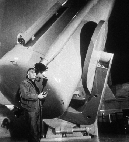
Edwin P Hubble
|
|
|
|
|
|
|
|
|
|
|
|
|
|
|
|
|
|
Edwin Powell Hubble (1889-1953)
 |
Edwin P Hubble |
So, who was Edwin P Hubble?
The son of Virginia and John Hubble, Edwin was born at Marshfield, Missouri, USA, on 20th November, 1889. Edwin seems to have been particularly close to his paternal grandfather, and his grandfather once had an article by the twelve year old Edwin published in a local newspaper. Not surprisingly, the article was about Mars.
What sort of education did Edwin Hubble receive?
Edwin went to Wheaton High School, as his father had an office in Chicago. At school he had a talent and interest in athletics and football. On graduation from Wheaton, he was awarded a half-fees scholarship to the University of Chicago, where he studied physics, astronomy and maths. He was awarded his B.S. degree in 1910 and then was given a prestigious Rhodes scholarship to study law at Queen's College, Oxford. Back in America, he passed the bar examination in 1913 and became an attorney at Louisville, Kentucky.
What did he do next?
Bored with the law, Edwin decided that astronomy was for him and re-entered the University of Chicago to study for his doctorate. He gained his Ph.D. in 1917, and almost immediately after completing the oral defence of his dissertation, went off to fight in the First World War.
What happened to Edwin after the war?
After having enlisted as a captain in the 343rd Infantry, 86th Division, he fought in France and eventually became a Major. In 1919, he became a civilian again in San Francisco and went to the Mount Wilson Observatory at Pasadena, California.
He married Grace Burke on 26th February, 1924 at Pasadena. This year he discovered a Cepheid, a variable star, in the Andromeda Nebulae. He was able to measure the distance to the Great Nebula and that of a number of other spiral nebulae using the powerful 100-inch telescope at Mount Wilson.
Hubble was able to show that the nearest spiral nebulae were galaxies of stars, clusters, dust and gas, like the Milky Way.
 |
Edwin Hubble at the guide telescope of the 1.2m Schmidt camera of the Palomar Observatory. (Carnegie Institution of Washington) |
Edwin Hubble made observations of the redshift in light wavelengths from the galaxies. He was able to deduce that they are moving away from our galaxy at a rate constant to the distance between them. This is known as Hubble's Law. He noted that the further away a galaxy is, the more rapidly it moves. Using this data, Hubble calculated that the "Big Bang" occurred 2 million years ago. Later evidence seems to indicate this was about 15-20 million years ago.
Was Edwin Hubble involved in World War II?
Edwin Hubble continued to work at Mount Wilson until 1942, when he wanted to become a member of the armed forces during World War II. He was not allowed to do so, but was involved in war duties at the Aberdeen proving Ground. This resulted in Hubble being awarded the Medal of Merit in 1946.
What happened after this war?
At the end of World War II, Edwin Hubble resumed work at the Mount Wilson Observatory. He had long wanted a larger telescope and had helped design a 200-inch Hale telescope. When this was finally built at Mount Palomar, Edwin became the first to use it.
What came next?
Hubble continued his research at Mount Wilson and Mount Palomar until his death from a cerebral thrombosis on 28th September, 1953. He died at San Marino, California. The Hubble Space Telescope, launched on 24th April, 1990, is named after him.
(For a translation of this page into Romanian see: (https://webhostinggeeks.com/science/zephyrus-edwinhubble-ro)